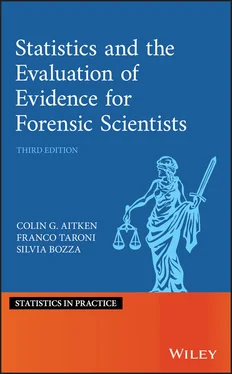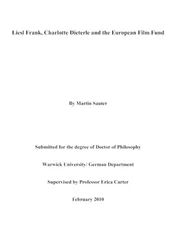Franco Taroni - Statistics and the Evaluation of Evidence for Forensic Scientists
Здесь есть возможность читать онлайн «Franco Taroni - Statistics and the Evaluation of Evidence for Forensic Scientists» — ознакомительный отрывок электронной книги совершенно бесплатно, а после прочтения отрывка купить полную версию. В некоторых случаях можно слушать аудио, скачать через торрент в формате fb2 и присутствует краткое содержание. Жанр: unrecognised, на английском языке. Описание произведения, (предисловие) а так же отзывы посетителей доступны на портале библиотеки ЛибКат.
- Название:Statistics and the Evaluation of Evidence for Forensic Scientists
- Автор:
- Жанр:
- Год:неизвестен
- ISBN:нет данных
- Рейтинг книги:3 / 5. Голосов: 1
-
Избранное:Добавить в избранное
- Отзывы:
-
Ваша оценка:
Statistics and the Evaluation of Evidence for Forensic Scientists: краткое содержание, описание и аннотация
Предлагаем к чтению аннотацию, описание, краткое содержание или предисловие (зависит от того, что написал сам автор книги «Statistics and the Evaluation of Evidence for Forensic Scientists»). Если вы не нашли необходимую информацию о книге — напишите в комментариях, мы постараемся отыскать её.
he leading resource in the statistical evaluation and interpretation of forensic evidence
The third edition of
is fully updated to provide the latest research and developments in the use of statistical techniques to evaluate and interpret evidence. Courts are increasingly aware of the importance of proper evidence assessment when there is an element of uncertainty. Because of the increasing availability of data, the role of statistical and probabilistic reasoning is gaining a higher profile in criminal cases. That’s why lawyers, forensic scientists, graduate students, and researchers will find this book an essential resource, one which explores how forensic evidence can be evaluated and interpreted statistically. It’s written as an accessible source of information for all those with an interest in the evaluation and interpretation of forensic scientific evidence.
Discusses the entire chain of reasoning–from evidence pre-assessment to court presentation; Includes material for the understanding of evidence interpretation for single and multiple trace evidence; Provides real examples and data for improved understanding. Since the first edition of this book was published in 1995, this respected series has remained a leading resource in the statistical evaluation of forensic evidence. It shares knowledge from authors in the fields of statistics and forensic science who are international experts in the area of evidence evaluation and interpretation. This book helps people to deal with uncertainty related to scientific evidence and propositions. It introduces a method of reasoning that shows how to update beliefs coherently and to act rationally. In this edition, readers can find new information on the topics of elicitation, subjective probabilities, decision analysis, and cognitive bias, all discussed in a Bayesian framework.

 ]. (p. 27)7
]. (p. 27)7 that can only take one of two values, namely, ‘true’ and ‘false’. There is a lack of information on the actual value of
that can only take one of two values, namely, ‘true’ and ‘false’. There is a lack of information on the actual value of  and an operational system is needed for the quantification of the uncertainty about
and an operational system is needed for the quantification of the uncertainty about  imparted by the lack of information. A value
imparted by the lack of information. A value  is regarded as an amount to be paid to bet on
is regarded as an amount to be paid to bet on  with the conditions that a unit amount will be paid if
with the conditions that a unit amount will be paid if  is true and nothing will be paid if
is true and nothing will be paid if  is false. In other words,
is false. In other words,  is the amount to be paid to obtain an amount equal to the value of
is the amount to be paid to obtain an amount equal to the value of  , that is associating the value 1 with ‘true’ and the value 0 with ‘false’. This idea was expressed by de Finetti (1940) in the following terms.
, that is associating the value 1 with ‘true’ and the value 0 with ‘false’. This idea was expressed by de Finetti (1940) in the following terms. is, according to Mr NN, equal to 0.37, meaning that if the person was forced to accept bets for and against event
is, according to Mr NN, equal to 0.37, meaning that if the person was forced to accept bets for and against event  , on the basis of the betting ratio
, on the basis of the betting ratio  which he can choose as he pleases, this person would choose
which he can choose as he pleases, this person would choose  . (p. 113) 8
. (p. 113) 8 does not make the player a certain loser or a certain winner. Denote an event which is certain, sometimes known as a universal set , as
does not make the player a certain loser or a certain winner. Denote an event which is certain, sometimes known as a universal set , as  and an event which is impossible, sometimes known as the empty set , as
and an event which is impossible, sometimes known as the empty set , as  so that if
so that if  and
and  the two possible gains are
the two possible gains are
 or
or  , there is no uncertainty in the outcome of the corresponding bet and so the coherence (in the absence of uncertainty) requires the respective gains to be zero. The values of the gains are therefore
, there is no uncertainty in the outcome of the corresponding bet and so the coherence (in the absence of uncertainty) requires the respective gains to be zero. The values of the gains are therefore










